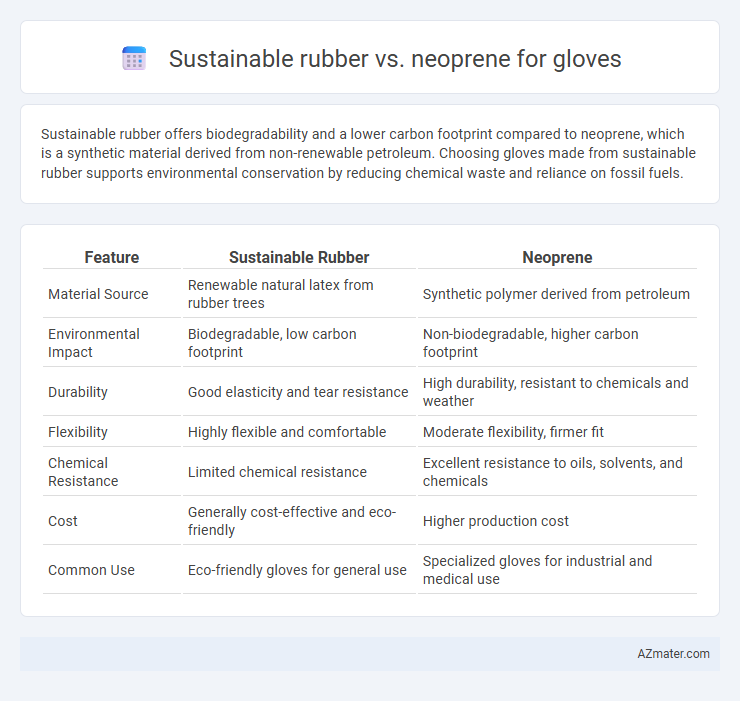Sustainable rubber offers biodegradability and a lower carbon footprint compared to neoprene, which is a synthetic material derived from non-renewable petroleum. Choosing gloves made from sustainable rubber supports environmental conservation by reducing chemical waste and reliance on fossil fuels.
Table of Comparison
| Feature | Sustainable Rubber | Neoprene |
|---|---|---|
| Material Source | Renewable natural latex from rubber trees | Synthetic polymer derived from petroleum |
| Environmental Impact | Biodegradable, low carbon footprint | Non-biodegradable, higher carbon footprint |
| Durability | Good elasticity and tear resistance | High durability, resistant to chemicals and weather |
| Flexibility | Highly flexible and comfortable | Moderate flexibility, firmer fit |
| Chemical Resistance | Limited chemical resistance | Excellent resistance to oils, solvents, and chemicals |
| Cost | Generally cost-effective and eco-friendly | Higher production cost |
| Common Use | Eco-friendly gloves for general use | Specialized gloves for industrial and medical use |
Introduction to Sustainable Rubber and Neoprene Gloves
Sustainable rubber gloves are made from natural latex sourced from rubber trees, emphasizing eco-friendly harvesting and biodegradability, reducing environmental impact compared to synthetic alternatives. Neoprene gloves, derived from synthetic rubber produced through polymerization of chloroprene, offer superior chemical resistance, durability, and flexibility but have a higher carbon footprint due to petrochemical origins. Choosing between sustainable rubber and neoprene gloves involves balancing environmental benefits with performance requirements such as chemical protection and longevity.
Material Origins: Natural vs Synthetic
Sustainable rubber originates from the latex sap of Hevea brasiliensis trees, offering a renewable and biodegradable material source that reduces environmental impact. Neoprene, a synthetic polymer produced through the polymerization of chloroprene, relies on petrochemical resources and involves energy-intensive manufacturing processes. The natural origin of sustainable rubber supports eco-friendly glove production, whereas neoprene's synthetic base raises concerns about carbon footprint and end-of-life disposal.
Production Processes and Environmental Impact
Sustainable rubber for gloves is derived from natural latex harvested from rubber trees, utilizing eco-friendly tapping methods that minimize deforestation and promote biodiversity. Its production involves renewable resources with lower carbon emissions and biodegradability, significantly reducing landfill waste compared to neoprene, which is a synthetic rubber made from petrochemicals requiring energy-intensive manufacturing and releasing volatile organic compounds (VOCs). The environmental impact of sustainable rubber is markedly less due to its renewable nature and reduced chemical usage, making it a preferred choice for eco-conscious glove production.
Durability and Performance Comparison
Sustainable rubber gloves offer exceptional elasticity and biodegradability while maintaining high resistance to wear, making them a durable choice for eco-conscious users. Neoprene gloves provide superior chemical resistance, thermal insulation, and abrasion durability, ideal for demanding industrial applications. Both materials deliver excellent performance, but neoprene excels in harsh environments due to its enhanced resilience and protective properties.
Biodegradability and End-of-Life Considerations
Sustainable rubber offers superior biodegradability compared to neoprene, breaking down naturally within a few years under proper environmental conditions, thus minimizing landfill impact. Neoprene is a synthetic polymer that resists degradation and can persist in ecosystems for decades, contributing to plastic pollution. End-of-life strategies for sustainable rubber gloves include composting and bioenergy recovery, whereas neoprene gloves often require incineration or long-term landfill storage, posing environmental challenges.
Health and Safety: Skin Sensitivities and Allergies
Sustainable rubber gloves significantly reduce skin sensitivities and allergic reactions compared to neoprene gloves, as they are derived from natural latex with fewer chemical additives. Neoprene gloves, made from synthetic rubber, often contain accelerators and chemical stabilizers that can trigger dermatitis and contact allergies in sensitive individuals. Choosing sustainable rubber gloves enhances health and safety by minimizing exposure to potential allergens, ensuring better skin compatibility for users with sensitive or allergy-prone skin.
Cost Analysis: Affordability and Market Trends
Sustainable rubber gloves generally offer competitive affordability driven by increasing demand for eco-friendly products and advancements in biodegradable material processing, resulting in lower long-term costs despite slightly higher upfront prices. Neoprene gloves maintain steady pricing due to established manufacturing efficiencies and widespread industrial use but face potential cost volatility linked to petrochemical price fluctuations. Market trends reveal growing consumer preference for sustainable rubber gloves, encouraging economies of scale that gradually narrow the cost gap with neoprene alternatives.
Industrial and Consumer Applications
Sustainable rubber offers eco-friendly benefits with biodegradable properties and reduced carbon footprint, making it ideal for industrial gloves requiring durability and chemical resistance in manufacturing and construction. Neoprene, known for its excellent flexibility, oil resistance, and thermal insulation, suits consumer gloves used in outdoor activities, sports, and household tasks. Both materials cater to specific performance needs, but sustainable rubber aligns better with growing environmental regulations and consumer demand for green products.
Regulatory and Certification Standards
Sustainable rubber gloves often comply with strict environmental certifications such as FSC (Forest Stewardship Council) and OEKO-TEX Standard 100, ensuring eco-friendly sourcing and non-toxicity. Neoprene gloves must meet stringent chemical resistance and safety regulations like EN 374 and ASTM F1342 to guarantee protective performance. Understanding these regulatory standards is essential for selecting gloves that balance sustainability with safety requirements in various industries.
Future Trends in Eco-Friendly Glove Materials
Sustainable rubber, derived from renewable natural sources, is gaining traction as an eco-friendly alternative to traditional neoprene, which is petroleum-based and less biodegradable. Innovations in sustainable rubber production emphasize reduced carbon footprints and enhanced biodegradability, aligning with global environmental regulations and consumer demand for greener products. Future trends indicate increased adoption of bio-based polymers and advanced recycling technologies to further minimize environmental impact in glove manufacturing.

Infographic: Sustainable rubber vs Neoprene for Glove
 azmater.com
azmater.com